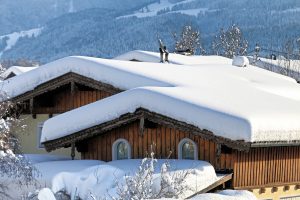Winter, especially in northern states, is probably the most damaging season for properties. Roofs receive the brunt of the impact, and homeowners with any winter roof issues should not wait until springtime to make assessments and repairs.
Following are three common winter rooftop issues, plus tips to handle those issues. If you are consistently aware of and mindful of the condition of your roof, you can be best prepared for any damage winter may bring.
1. LEAKS FROM ICE DAMS & ICICLES
Both ice dams and icicles form because of warm air rising from the home to the shingles of the roof. The warm air melts the snow on the shingles. That melted water then travels to colder areas of the roof’s edges, where it freezes again, forming ice.
Excessive ice buildup causes melting snow to drip under the roof’s shingles and then into the home, causing leaks. Further freezing and thawing can cause any cracks in the home’s substrates to expand, aggravating existing leaks. If icicles form as a result of this freezing process, they can not only ruin gutters, but they can also fall and hurt people walking below.
The best way to avoid these issues is to insulate and ventilate your home. If you can clear your downspouts and gutters before winter arrives, you can significantly reduce the risk of winter roof damage. When it does start to snow, clear the snow from the corners of your roof with a roof rake. Another solution is installing heat trace cables in your gutters to prevent ice from forming and building up.
To remove icicles, use a long-handled roof rake or a ladder to reach them. Please note the danger of placing a ladder on icy ground or using a ladder that is unstable. If there is ice on the roof, wait to climb onto it until conditions improve.
2. MOISTURE IN THE ATTIC
Attic condensation, or the accumulation of moisture, is also a high possibility, especially if you see any signs of ice dams or icicles forming on your roof. This additional issue can cause mold and wood damage to occur.
To avoid this problem, make sure to seal any gaps in your insulation where moist air can enter your home. Equipment in your home that is not functioning correctly can also cause extra moisture to accumulate, such as problematic plumbing or malfunctioning dehumidifiers. Monitor these systems and appliances throughout the year—not just during the wintertime.
3. DANGEROUS SNOW WEIGHT

Some homeowners may not know that roofs are designed to support only a certain weight. If homeowners allow ice and snow to build up on their roofs, there is a possibility that the roof could collapse. Homeowners should be especially aware of wet snow buildup, as that is the heaviest kind of snow. If a roof is not properly drained or structured, the risk of sagging and leaks grows drastically.
Contact a roofing expert if you see unusually heavy snow buildup on your roof.
TAKE CARE OF YOUR ROOF
Maintain a healthy roof in all seasons by staying aware of its condition. If you notice your roof may have damage, make repairs before severe weather hits.
If roof damage occurs as a result of a winter storm and the damage needs repairing, contact your insurance company. American Roof Supplements is also here to help, making sure that all necessary repairs are made and that your insurance company covers all costs.
Questions? Call us or submit the contact form.
